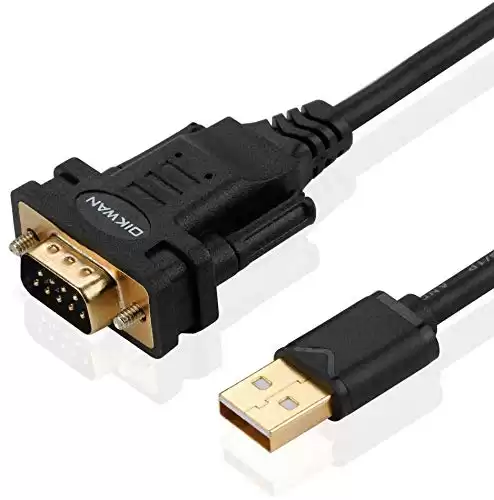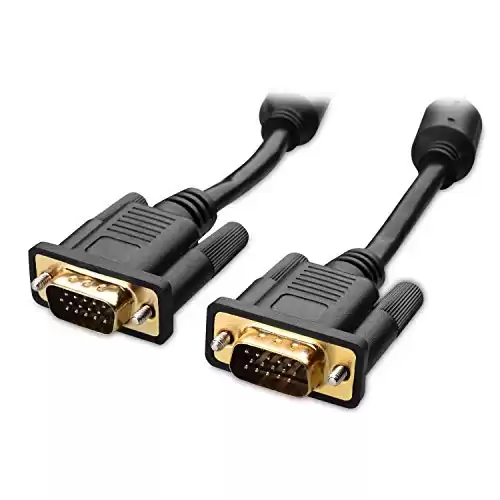
Key Points
- RS232 and VGA are not interchangeable and are different in every way.
- RS232 was developed in the 1960s to connect peripherals to computers, while VGA was introduced in 1987 to replace EGA with better resolution and color depths.
- RS232 connectors have 9 pins for horizontal data transfer, while VGA connectors have 15 pins for both horizontal and vertical communication.
- RS232 is a serial interface that transfers information one bit at a time, while VGA transmits voltage levels for displaying graphics.
- RS232 became obsolete in the early 2000s, while VGA saw longer use until the early 2010s and was replaced by DVI, HDMI, and DisplayPort.
So what do they do and which one should you use? In this article, we talk about how each came about, what their functions are, and which you’re more likely to use with modern technology. Let’s get into it.
RS232 vs VGA: Side-by-Side Comparison

RS232 vs VGA: What’s the Difference?
RS232 (Recommended Standard 232) was developed in the early 1960s as a method of connecting peripherals to computers. Technicians at the Electronic Industries Association needed a way to transfer information that devices such as modems, printers, and mice were trying to convey.
The original RS232 design featured 25 pins but was too large for consumer use. The connector found only specific applications until the late 1980s, when it was redesigned as a slimmer DB-9.
The popular VGA (Video Graphics Array) connector wasn’t seen until decades later. Introduced by IBM in 1987, it aimed to replace the EGA with better resolution and color depths. Featuring displays as high as 800×600 pixels, it quickly became the dominant connector for video display.
The original DE-15 design worked well for several years, but as the resolution changed and evolved from 640×480, IBM needed to tweak the port. The new HD-15 featured the same amount of pins but with smaller spacing for greater compactness. It became the prominent model, and the one most commonly used in discussions on the topic.
Port Connectors
The port design is where people typically confuse RS232 and VGA. At first glance, it’s easy to mistake one for the other; after all, they both share the same D-shaped design. This is typically called a D-sub connection and has been used in several historic port models. However, this is about as close as the two get to being similar.
With a closer look, you’ll notice that RS232 connectors feature 9 pins. These help with data transfer on a horizontal level. It uses these pins to control signals such as Request to Send (RTS) and Clear to Send (CTS).
The VGA connector, on the other hand, has 15 pins in its design. These allow it to talk to the computer on both a horizontal and vertical level. Additionally, VGA uses its pins to carry a wide range of voltage levels for red, green, and blue channels.

Functions
While the two look similar in design, they have different applications.
RS232 is a serial interface, meaning it uses a single communication line to transfer information one bit at a time. It sends commands using start and stop bits, framing each data byte. This allows the computer and peripheral to talk without needing to sync signal timing.
VGA works with multiple communication lines to display graphics. It transmits voltage levels that correspond to the colors and brightness of the image it’s trying to display. For this, it communicates both horizontally and vertically. However, because it sends no demands, VGA has no start-stop feature.
Obsolescence
The RS232 maintained popularity well into the late 1990s. However, with the rise of information technology, the connector became too bulky for practical use. Computer designs started to opt for USB ports, which promised faster communication in a smaller model. Since the early 2000s, RS232 was considered obsolete and was rarely seen in mainstream devices.
VGA saw slightly longer use, well into the early 2010s. However, much like other D-sub connectors, it too lost popularity with the need for smaller and faster ports. VGA was replaced with three main interfaces: DVI (Digital Visual Interface), HDMI (High-Definition Multimedia Interface), and DisplayPort.
RS232 vs VGA: 6 Must-Know Facts
- People often confuse RS232 and VGA for their D-shaped port design, which is commonly called a D-sub connection.
- RS232 and VGA differ in their design in that the former has only 9 pins, while the latter has 15.
- RS232 was developed in the early 1960s as a method for allowing peripherals to communicate with the computer.
- VGA was developed over 20 years later as an improvement on the EGA, a communication path for displaying images and videos on a monitor.
- RS232 became obsolete in the early 2000s. USB replaced it with its quicker transfer speeds and smaller design.
- VGA became obsolete about 10 years later, with HDMI and Display ports replacing it for similar reasons.
RS232 and VGA work similarly, but their functions differ significantly. One bridges communication between peripherals and the computer, and the other strictly displays images. More importantly, neither port does the same task as the other.
However, because they’re both outdated, it’s unlikely you’ll use either. For modern computers, you’re likely to use USB for peripherals and HDMI for display. But this information is worth knowing if you’re working with antique technology.
1.OIKWAN USB to RS232
- USB 2.0 to RS232 male DB9
- Supports data transfer speeds up to 1Mbps
- FTDI USB serial with the latest FTDI chipset
- Geared for devices such as GPS, routers, serial modems, barcode scanners, label writers, digital cameras, and card readers

2.Cable Matters VGA to VGA Cable 10ft With Ferrites
- Contains 10 foot VGA to VGA cable
- Comes with a screw-in VGA cable
- Support high-resolution LCD and LED monitors
- Clear, quality transmission


















No comments:
Post a Comment
Comment